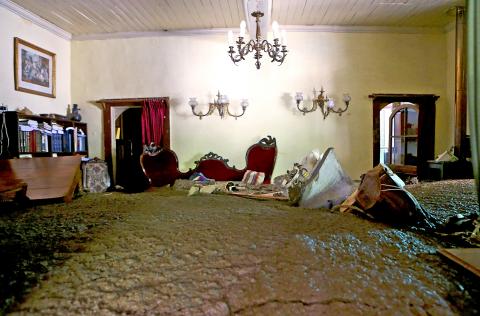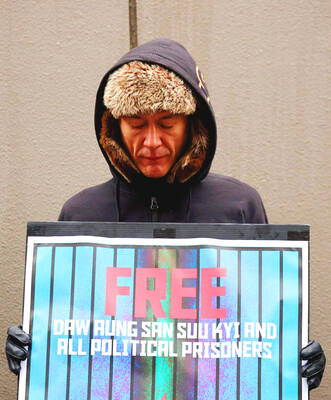Rainstorms and landslides in Chile killed four and contaminated a major river, forcing authorities to cut off drinking water to 4 million people in the capital, authorities said.
The torrential rain that started on Saturday prompted mudslides and rubble to surge into the Maipo River, which supplies most homes in the capital.
“We are talking about 1.45 million homes that are going to be affected by the cutting off of the water supply, which will be total or partial in 30 districts” of Santiago, Santiago Metropolitan Region Governor Claudio Orrego told a news conference.

Photo: AP
He said the cut would therefore affect more than 60 percent of the city’s 6.5 million population — about 3.9 million people.
The move prompted many people to go out with buckets and pans to collect water at emergency water taps made available by the authorities.
Others rushed to supermarkets to bag bottles of water from the shelves.
“We still do not know when the drinking water will be turned back on,” Orrego told reporters.
“We cannot guarantee resumption of the service until the River Maipo clears up,” he added.
Authorities ordered restaurants and businesses without drinking water to stay closed.
They also postponed the start of a new school term yesterday.
The Chilean Ministry of the Interior said four people were known to have died and six were missing due to the rain.
A rainstorm hit near the river in the countryside east of Santiago.
“The force of nature swept away bridges and left 1,200 people cut off” in Cordillera Province, provincial Governor Vanessa Marimon said.
The ministry said 3,300 people were cut off overall by floods.
Heavy rain also caused flooding in the northern Antofagasta region and in the tourist district of San Pedro de Atacama.
“Emergency teams are working on the ground to connect with isolated persons and re-establish the water supply wherever possible,” Chilean President Michelle Bachelet wrote on Twitter.
In the O’Higgins region, south of Santiago, a 12-year-old girl was killed when a landslide swept away the car in which she was traveling.
In the San Jose de Maipo Valley, directly above the city, emergency crews had to clear streets and roads of debris before residents could evacuate to lower, less mountainous ground.
It was the second major flooding event to hit central Chile in the past year. In April last year, heavy rains battered the San Jose de Maipo Valley, killing one and shutting production at some of the largest copper mines in the world.
Mining giants Antofagasta, state-owned Codelco and Anglo American have sizeable deposits in the zone affected by this weekend’s rains.
All three said production had not been affected.

The Burmese junta has said that detained former leader Aung San Suu Kyi is “in good health,” a day after her son said he has received little information about the 80-year-old’s condition and fears she could die without him knowing. In an interview in Tokyo earlier this week, Kim Aris said he had not heard from his mother in years and believes she is being held incommunicado in the capital, Naypyidaw. Aung San Suu Kyi, a Nobel Peace Prize laureate, was detained after a 2021 military coup that ousted her elected civilian government and sparked a civil war. She is serving a

China yesterday held a low-key memorial ceremony for the 1937 Nanjing Massacre, with Chinese President Xi Jinping (習近平) not attending, despite a diplomatic crisis between Beijing and Tokyo over Taiwan. Beijing has raged at Tokyo since Japanese Prime Minister Sanae Takaichi last month said that a hypothetical Chinese attack on Taiwan could trigger a military response from Japan. China and Japan have long sparred over their painful history. China consistently reminds its people of the 1937 Nanjing Massacre, in which it says Japanese troops killed 300,000 people in what was then its capital. A post-World War II Allied tribunal put the death toll

‘NO AMNESTY’: Tens of thousands of people joined the rally against a bill that would slash the former president’s prison term; President Lula has said he would veto the bill Tens of thousands of Brazilians on Sunday demonstrated against a bill that advanced in Congress this week that would reduce the time former president Jair Bolsonaro spends behind bars following his sentence of more than 27 years for attempting a coup. Protests took place in the capital, Brasilia, and in other major cities across the nation, including Sao Paulo, Florianopolis, Salvador and Recife. On Copacabana’s boardwalk in Rio de Janeiro, crowds composed of left-wing voters chanted “No amnesty” and “Out with Hugo Motta,” a reference to the speaker of the lower house, which approved the bill on Wednesday last week. It is

FALLEN: The nine soldiers who were killed while carrying out combat and engineering tasks in Russia were given the title of Hero of the Democratic People’s Republic of Korea North Korean leader Kim Jong-un attended a welcoming ceremony for an army engineering unit that had returned home after carrying out duties in Russia, North Korean state media KCNA reported on Saturday. In a speech carried by KCNA, Kim praised officers and soldiers of the 528th Regiment of Engineers of the Korean People’s Army (KPA) for “heroic” conduct and “mass heroism” in fulfilling orders issued by the ruling Workers’ Party of Korea during a 120-day overseas deployment. Video footage released by North Korea showed uniformed soldiers disembarking from an aircraft, Kim hugging a soldier seated in a wheelchair, and soldiers and officials